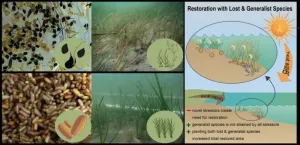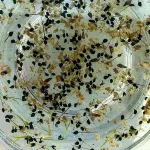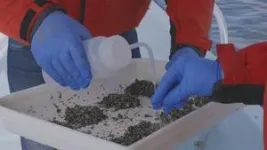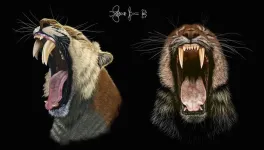(Press-News.org) New research demonstrates that seagrass habitat restoration can be enhanced by including other grasses in addition to the declining or lost species and – ultimately – that restoration efforts must proactively select species that can withstand current and intensifying stressors driven by human activities and climate change.
Rising global temperatures combined with centuries of humans working within our seascapes has reshaped coastal ecosystems. Rebuilding or restoring coastal habitat is becoming a top priority for natural resource conservation and as an insurance policy for the provision of critical services including shoreline protection, clean water, and seafood. Yet, successful habitat restoration is still rare, and most efforts are unsustainably expensive and labor intensive.
“Any gardener knows the difficultly in mastering how to grow a plant from seed or a clipping, and the same goes for restoration practitioners using habitat-forming species – discovering the perfect conditions.” says Enie Hensel, lead-author, postdoctoral researcher at UF IFAS SWES Nature Coast Biological Station and former postdoctoral researcher at William & Mary’s Virginia Institute of Marine Science (VIMS).
Seagrasses are experiencing global declines and, in the Chesapeake Bay, United States, where this study was conducted, intensifying heat waves are a main cause for declines in the dominant seagrass, eelgrass (Zostera marina). Recent research has shown the most successful restorations span large areas and location selection is key. The location should have a certain sand or sediment type, water quality level, temperature range, and the presence of beneficial ‘bugs’ or invertebrates that graze off grass-smothering algae – all of which are dependent on grass identity (M. M can Katwijk et al., 2016).
“These novel environmental conditions are a challenge for restoration. But what tends to always thrive in someone’s yard, no matter how hard one caters to their prized lawn grass, are weeds. And this fact might translate well to seagrass restoration – incorporating ‘weedy,’ or generalist, seagrass species that aren’t necessarily the targeted species for a given restoration,” says Enie.
“This project is important because Chesapeake Bay eelgrass has been declining for the past 30 years due to warming waters and we need to start thinking about alternative restoration strategies that accommodate this shifting environmental baseline. Here, we included a widely distributed generalist seagrass, widgeongrass [Ruppia maritima], which increases the portfolio of species diversity, providing some insurance that helps enhance long term restoration success.” says co-author Christopher J. Patrick, co-lead of the Submerged Aquatic Vegetation Restoration portion of the U.S. Army Corps of Engineer’s Lynnhaven River Basin Ecosystem Restoration Project and director of the Chesapeake Bay’s SAV Monitoring and Restoration Program
For this study, Enie and her collaborators leveraged a planned seagrass restoration in the lower Chesapeake Bay and conducted a field experiment to evaluate (1) which seeding methods yielded the most widgeongrass growth, tested if seeding widgeongrass next to eelgrass can increase restoration success, and quantified how either seagrass species changes restored bed structure, invertebrate communities, and nitrogen cycling. In the following year, researchers operationalized their experimental findings during a multi-acre pilot restoration.
“This is the first large-scale restoration effort in the lower Chesapeake Bay to use widgeongrass, and one of the few field experiments to identify how to best grow widgeongrass in the wild,” Enie says.
In the experiment, hand-seeded widgeongrass successfully grew. The highest survival and growth were when seeding mimicked nature and for this study that meant seeding widgeongrass in the fall with no pre-seed treatment – an advantageous finding for practitioners as it requires the least effort. Additionally, by seeding both widgeongrass and eelgrass, the restoration nearly doubled in size as widgeongrass was seeded in the shallows where water temperatures were above local practitioners’ recommendation for eelgrass restorations.
“Two exciting findings: these young widgeongrass beds were, one, full of epiphytic algal grazers, the ‘beneficials’ for a seagrass meadow and two, recycled less nitrogen than its surrounding sandy substrate. While this trend will likely change as widgeongrass matures, young widgeongrass recycling a negligible amount of nitrogen in a nutrient-rich area should have a positive effect on both grasses by not further increasing available nutrients, a known seagrass stressor in human-influenced systems like the Virgina Beach area” says Enie.
This study was a part of the initial phase for SAV Restoration led and supported by William G. Reay of the Chesapeake Bay National Estuarine Research Reserve (NOAA NOS/OCM, NA21NOS4200127) at VIMS as well as Robert J. Orth and Christopher J. Patrick of VIMS (NSF OCE 1737258 and 1658135) for the ‘Lynnhaven River Basin Ecosystem Restoration Project’ led and funded by the U.S. Army Corps of Engineers with local Norfolk District USACE (W912HZ-20-2-0021) as well as collaboration with City of Virginia Beach Department of Defense.
END
Let widgeongrass be a weed in the seagrass yard -- making seagrass restoration more resistant to rising temperatures using generalist grasses
2024-04-30
ELSE PRESS RELEASES FROM THIS DATE:
Group sales incentives boost weak brand sales, study finds
2024-04-30
New research co-authored by a UC Riverside business professor provides some sound advice for managers of retail outlets that limit their product selection to a particular brand: Managers should factor in the strength of their brand when structuring the pay incentives for their sales staff.
The study focused on what marketing scholars call “brand-managed” retail operations. These outlets include “stores within stores,” such as counters in major department stores with dedicated sales staff that offer just one brand of cosmetics such as Clinique. They can also be stores ...
The double-fanged adolescence of saber-toothed cats
2024-04-30
The fearsome, saber-like teeth of Smilodon fatalis — California's state fossil — are familiar to anyone who has ever visited Los Angeles' La Brea Tar Pits, a sticky trap from which more than 2,000 saber-toothed cat skulls have been excavated over more than a century.
Though few of the recovered skulls had sabers attached, a handful exhibited a peculiar feature: the tooth socket for the saber was occupied by two teeth, with the permanent tooth slotted into a groove in the baby tooth.
Paleontologist Jack Tseng, associate professor of integrative biology at the University of California, Berkeley, doesn't think the double fangs ...
COVID-19-induced financial hardships reveal mental health struggles
2024-04-30
When COVID-19 caused significant economic disruptions, thousands of people around the world experienced sudden shocks to their financial situation through reduced earnings or job losses.
Now economic researchers at the University of South Australia have examined the mental health effects on people who experienced immediate or expected financial setbacks during the height of the pandemic.
Data gathered from China, Japan and South Korea during the early phases of the pandemic revealed that the severe economic shocks induced by COVID-19 caused significant ...
Healthy lifestyle may offset effects of life-shortening genes by 60%+
2024-04-30
A healthy lifestyle may offset the effects of life-shortening genes by more than 60%, suggests an analysis of the findings from several large long term studies, published online in the journal BMJ Evidence Based Medicine.
While genes and lifestyle seem to have an additive effect on a person’s lifespan, an unhealthy lifestyle is independently linked to a 78% heightened risk of dying before one’s time, regardless of genetic predisposition, the research indicates.
The polygenic risk score (PRS) combines ...
Frequent teen vaping might boost risk of toxic lead and uranium exposure
2024-04-30
Frequent teen vaping might boost the risk of exposure to lead and uranium, potentially harming brain and organ development, suggests research published online in the journal Tobacco Control.
The findings underscore the need for implementation of regulations and prevention efforts targeting teens, emphasise the researchers.
Vaping is popular with teens. In 2022, an estimated 14% of US high school students—around 2.14 million—and more than 3% of middle school students—around 380,000—reported vaping in the preceding month, note the researchers.
Certain metals have been identified in e-cigarette aerosols and ...
Fentanyl inhalation may cause potentially irreversible brain damage, warn doctors
2024-04-30
Inhaling the synthetic opioid fentanyl may cause potentially irreversible brain damage (toxic leukoencephalopathy), warn doctors in the journal BMJ Case Reports, after treating a middle aged man found unresponsive in his hotel room after snorting the drug.
Leukoencephalopathy refers to inflammation and damage to the brain’s white matter—the network of nerve fibres that enable the exchange of information and communication between different areas of the brain’s grey matter.
Toxic leukoencephalopathy is a sudden or longstanding neurological syndrome, which ...
OHSU patient is world’s first documented case of brain disease from fentanyl inhalation
2024-04-30
The man arrived unconscious and near death.
Previously healthy with no known medical history, the 47-year-old arrived by ambulance to the emergency department at Oregon Health & Science University on Feb. 25, 2023. He was found collapsed in his hotel room, where he was staying during a business trip. As clinicians began administering life-saving treatment, they searched for the cause.
In a case report published online today in the journal BMJ Case Reports, clinicians laid out the surprising and unprecedented diagnosis: toxic ...
Microarray patches safe and effective for vaccinating children, trial shows
2024-04-30
EMBARGOED UNTIL 23:30 UK TIME MONDAY 29 APRIL 2024
Peer-reviewed/Randomised Control Trial/Humans
The phase 1/2 randomized trial compared results from the measles and rubella vaccine delivered by a microarray patch, a small sticking plaster-like device with an array of microscopic projections that painlessly penetrate the skin and deliver the vaccine, or by conventional injection with a needle and syringe.
The trial, which involved 45 adults (18-40 years old), 120 toddlers (15-18 months old) and 120 infants (9-10 months old) in The Gambia, ...
Montana State scientists’ research on RNA editing illuminates possible lifesaving treatments for genetic diseases
2024-04-30
BOZEMAN – A team at Montana State University published research this week that shows how RNA, the close chemical cousin to DNA, can be edited using CRISPRs. The work reveals a new process in human cells that has potential for treating a wide variety of genetic diseases.
Postdoctoral researchers Artem Nemudryi and Anna Nemudraia conducted the research alongside Blake Wiedenheft, professor in the Department of Microbiology and Cell Biology in MSU’s College of Agriculture. The paper, titled “Repair of CRISPR-guided RNA breaks enables site-specific RNA excision ...
UC Irvine astronomers’ simulations support dark matter theory
2024-04-30
Irvine, Calif., April 29, 2024 — Computer simulations by astronomers support the idea that dark matter – matter that no one has yet directly detected but which many physicists think must be there to explain several aspects of the observable universe – exists, according to the researchers, who include those at the University of California, Irvine.
The work addresses a fundamental debate in astrophysics – does invisible dark matter need to exist to explain how the universe works the way it ...




